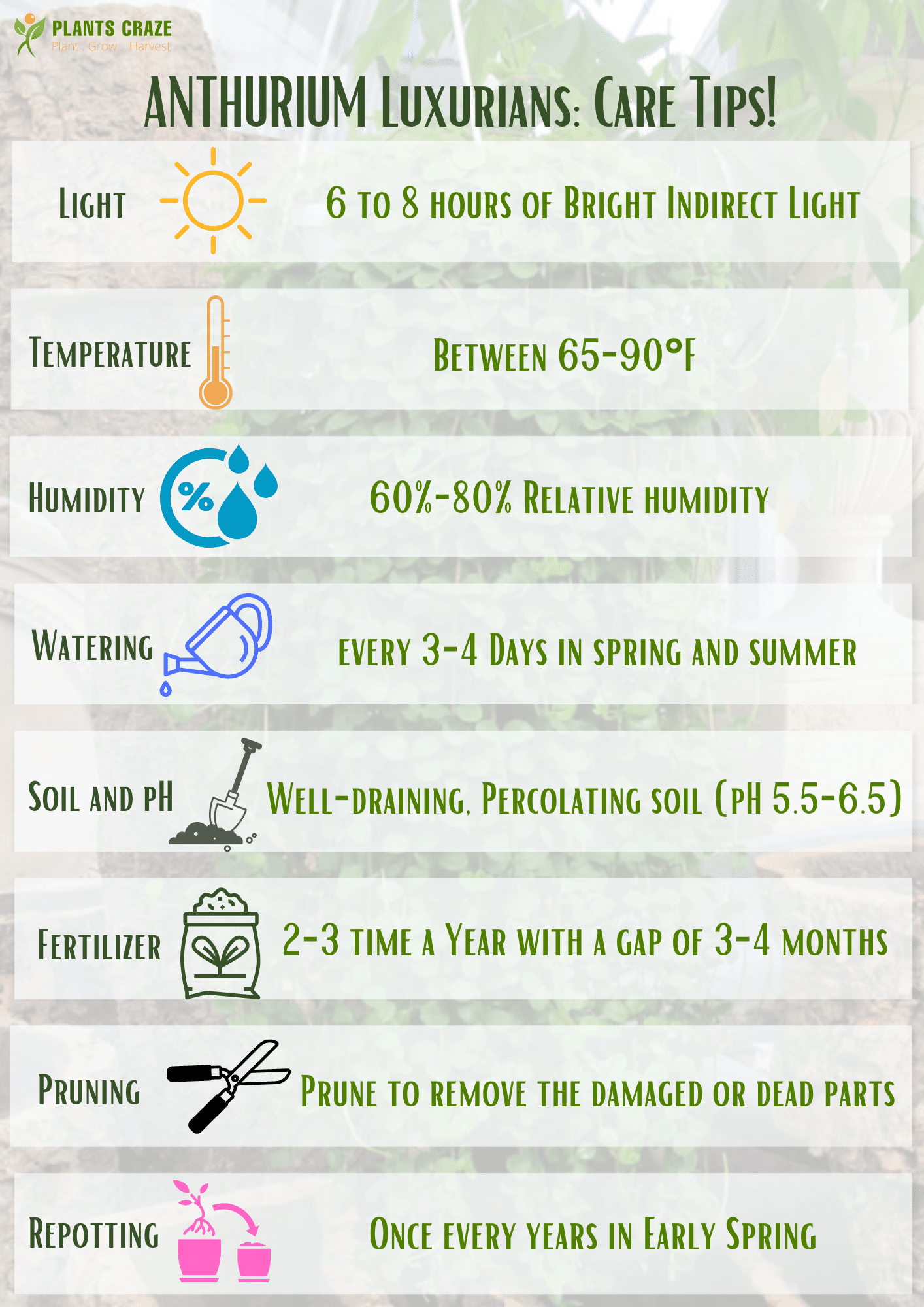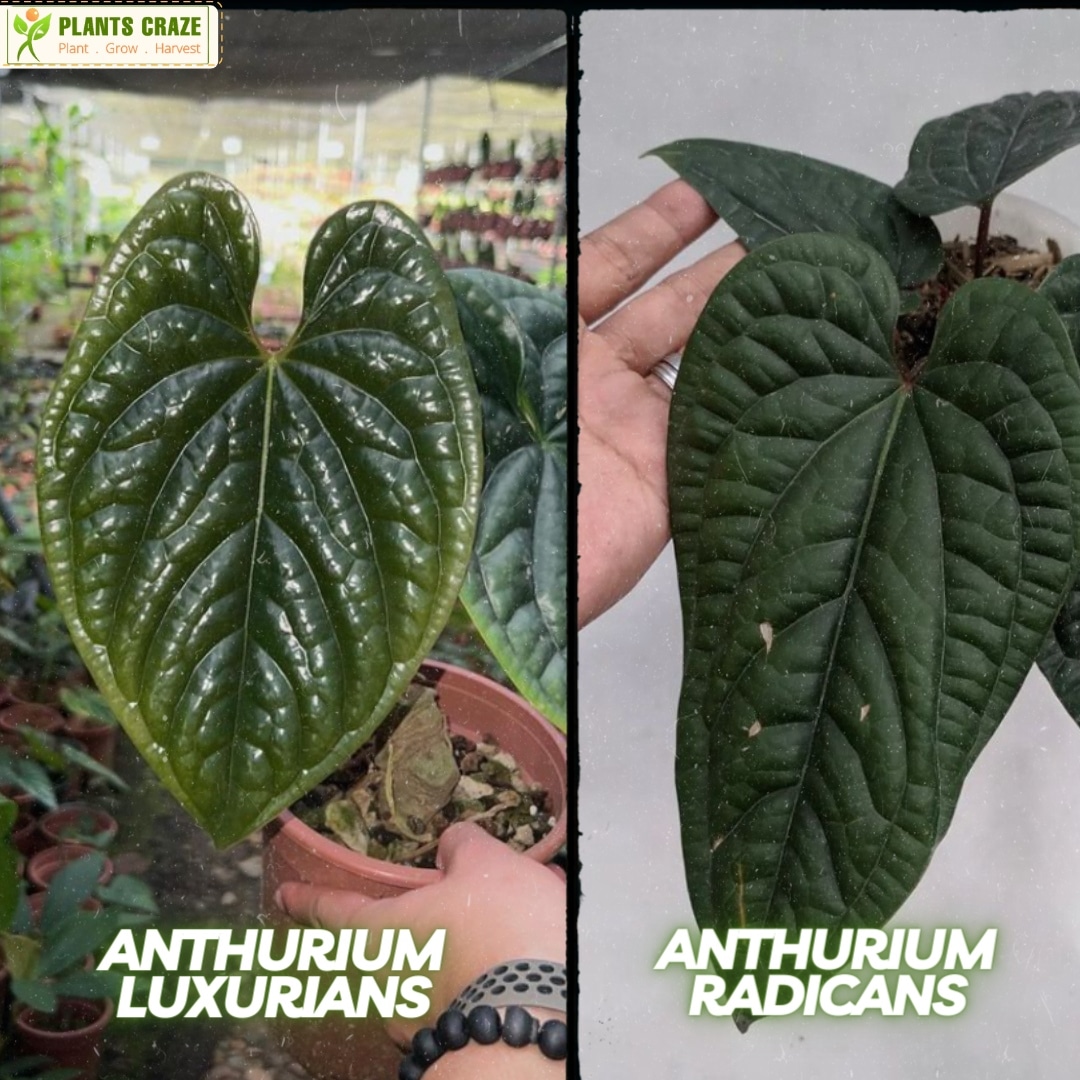The signature deep green heart-shaped foliage with blistered texture and surprisingly easy care makes Anthurium luxurians popular among plant lovers.
Follow the care guide till the end to minimize the mistake and promote the successful growth of Anthurium luxurians.
Table of Contents Show
Anthurium Luxurians Overview
Anthurium luxurians is native to South America but was discovered in the Columbia rainforest.
| Indicator | Identity |
|---|---|
| Scientific name | Anthurium luxurians |
| Common name | Anthurium, Tail Flower, Flamingo Flower, Lace Leaf, Quilted Hearts |
| Family | Araceae |
| USDA zone | 10-12 |
| Nature | Tropical evergreen epiphyte |
| Growth Rate | Slow to moderate |
| Foliage | A pale porcelain colored young bullate leaves turning dark green over time |
| Maximum size | 15 inches height with leaves up to 2.1 feet in length |
| Blooms | Creamy white spathe and pink-red inflorescence |
| Toxicity | Toxic to pets and humans |
Don’t get Confused!! Luxurians were formerly known as Anthurium Splendidum but are two different plants.
Care Advice For Anthurium Luxurians
If you have Anthurium luxurians in your home or intend to bring it someday, focus on optimal conditions to let it grow to its full potential.

1. Sunlight and Temperature
Bright filtered sunlight with warm temperatures, similar to the tropical rainforest, is ideal for the Anthurium luxurians.
Though the aroid plant prefers a warm temperature, keeping it away from harsh sunlight is better as it scorches, burns, and discolors the beautiful foliage.
And while balancing the light, do remember not to let the temperature drop below 50ºF with the light as it stunts the plant growth and gives droopy leaves.

The best indoor location is 2-3 feet away from the south-facing window, and if there is inadequate light, install grow light.
For safety, keep the Anthurium luxurians away from the heating and cooling vents to prevent fluctuating temperatures.
2. Water & Humidity
Anthurium luxurians is a humidity lover ranging from 60-80%, with watering once every 3-4 days on summer days.
Meanwhile, Anthurium luxurians are more drought-sensitive when the new leaf grows out. It needs more water to develop into big leaves.
So follow the watering schedule and humidity since low humidity causes curling and brown tips in leaves. At the same time, high humidity causes bacterial and fungal diseases.
To maintain the humidity level, use a humidifier, try the pebble tray method, or place them in the kitchen or bathroom.
The Anthurium luxurians enter the dormancy stage during winter so watering in intervals of 10-12 days is enough.
3. Soil & Fertilizer
The soil perfect for Anthurium luxurians should have proper aeration, be well-draining, nutrient-rich, and be slightly acidic (5.5-6.5 pH).
These mixes might require less fertilizer but enrich the DIY mix with a slow-release fertilizer once every three months in the growing season. Make sure to dilute the fertilizer to 1/4th of the strength.
Let the plant rest during dormancy in winter, or else overfertilization may occur, causing burns and brown margins on the leaves.
You can also check on overfertilization by looking at the salt accumulated on the surface of the soil mix. Treat it by washing off the soil in running water.
4. Potting and Repotting
Anthurium luxurians can adjust themselves in a container for a long time if provided with a terracotta pot of 5 inches.
However, you can try repotting your Anthurium luxurians yearly or when the plant outgrows the current pot to promote healthy growth.
You can start the repotting by watering the plant a day before repotting to loosen the soil.
Then, gently remove the Luxurians from the container, separate root bounds, and cut the damaged roots by wearing gardening gloves.
Fill a terracotta or plastic pot, one size bigger than the previous one, and half-fill with potting mix. Place the plant in the center and cover the remaining.

Remember, the best time for repotting Luxurians is in spring and summer.
It prevents repotting stress and lets the plant quickly adjust to the new environment compared to winter.
Do not fertilize the plant for six months after repotting, as the mix already contains slow-releasing fertilizer.
5. Occasional Pruning
Prune the Anthurium luxurians annually just before or in the growing season whenever you see discolored foliage, yellow leaves, or infected parts.
Improper watering and high humidity facilitate the breeding of pests like Mealybugs, Spider mites, Thrips, Scales, and Aphids that suck the sap of the leaves.
To identify their presence, look over the symptoms like a yellow halo, white residues, black spots, and droopy leaves.
After identifying, treat the pests by spraying insecticidal soap or neem oil. You can also place the plant under running water or dab it with alcohol-dipped cotton swabs.
The conditions inciting pests also lead to the attack of diseases like Rhizoctonia solani, Bacterial blight, and Bacterial wilt.
The diseased Anthurium luxurians show symptoms like yellow, wilted leaves, a mushy smell from the base, brown spots, and falling leaves.
Separate the infected plant from the group and prune off the damaged leaves. Also, treat other Luxurians with a copper-rich fungicide to prevent further spread.
Anthurium Luxurians: All About Growth Rate
Anthurium luxurians grow slowly and steadily at their own pace to reach a height of 15 inches, taking 3 to 4 weeks to give a new leaf.
The young leaf of Luxurians is light green and golden bronze that later turns into dark black-green, attaining about 2.1 feet in length and 1.6 feet in width.
However, a single leaf can sometimes grow up to 25 inches long and 18 inches wide, given the compact size of Luxurians.
Also, the Anthurium luxurians have short stems with thick heart-shaped leaves stretching over them.
Meanwhile, the blooms with creamy white spathe and pink-red inflorescence appear on the base background compared to the showy floral displays of other Anthurium flowers.
When the plant reaches full maturity in the right environmental conditions, the flower bloom throughout the year.
Toxicity of Anthurium Luxurians
According to the ASPCA, Calcium Oxalate Crystals are present in Anthurium luxurians, making it toxic to humans and pets.
If ingested, it causes oral irritation, vomiting, and uneasiness to the pets, whereas breathing difficulty, lips swelling, and allergies to people.
And in case of ingestion or severe cases caused by Anthurium luxurians, contact the immediate helpline number.
Propagation Methods for Anthurium Luxurians
Being a rare and expensive Anthurium variety, learning to propagate the Luxurians will save money and help you include more members in the collection.
Meanwhile, propagating Anthurium is easy. Also, you can multiply Luxurians using three possible methods.
1. Propagation through Planting the Seeds
Seed propagation takes longer, so you need to be patient and let the plant grow at its own pace.
- Collect the seed from the bloom of the Anthurium or buy from online stores.
- Soak the seed in water for at least two hours.
- Fill a terracotta or unglazed ceramic pot with a potting mix similar to a mature plant mix.
- Then, sprinkle the seed over the soil and ensure not to sow deep.
- Afterward, mist the soil to moisten it and place it in a greenhouse or area with ample light.
- You can also cover the pot with plastic to maintain humidity and protect it from enemy attack.
Let the roots develop fully before repotting to a new container as the new shoot of the Luxurians sprouts within two months of sowing.
2. Propagation through Division of the Roots
Propagating the Anthurium luxurians through the division of the roots is an easy and fast method.
- Firstly, take the plant out carefully from the container. Make sure not to damage the roots.
- Untangle the root bound with your hands or a sterilized knife.
- Inspect the root and look for petioles growing from the rhizomes in the roots.
- Cut the roots with a sterilized knife without damaging them.
- Remember, the plant must contain both the stem and roots to propagate.
- Finally, plant the divided roots in the soil and water them appropriately.
Cuttings will show growth within 3-4 weeks if provided with ideal conditions for development.
After propagating, the plant experiences shock but slowly adjusts to the new environment. When the cuttings develop several fresh leaves, you can repot them.
3. Propagation through Stem Cuttings
You can perform Luxurians’ propagation through stem cuttings in soil and water.
- Firstly, take the whole plant from the pot.
- Cut the stems into several pieces at least 4-5 inches long with a mature leaf or leaf bud on top.
- Dip the cutting in cinnamon powder to prevent bacterial infections.
- Then, plant the stem in a potting mix and cover the pot with plastic. This help to maintain moisture and humidity for growth.
- Under optimal growth requirements, the cutting will develop roots and leaves within a few weeks.
- When the plants grow large enough to handle, transplant them into a large pot.
You can propagate the cut stem or divided roots in a jar or glass with water.
But take special care when propagating Anthurium luxurians through a water medium, as leaves or stems are more likely to rot.
- Submerge the bottom of the stem cuttings and roots ( for root division) entirely in water.
- However, do not let the leaves be underwater, as they will rot.
- Keep on inspecting the plant for root growth.
- After the roots develop, repot them in a well-draining potting medium.
Get a reference from this video!
Where to Buy Anthurium luxurians
After learning all the step-wise care for Anthurium luxurians, you are ready to bring one of the rare varieties into your home.
Anthurium luxurians price can, however vary considering its peak season.
| Store | Delivery Time |
|---|---|
| Vedas Plant Shop | 1-3 business days |
| Carnivero | 2-8 business days |
| Ecuagenera | 15-30 business days |
| Etsy | 10-17 business days |
Anthurium Luxurians Vs. Anthurium Radicans
Radicans and Luxurians resemble each other, for they both have bullate leaves with bumps on the surface.
However, the difference that tells them apart is the leaves of Radicans are more pointed and lighter in the shade than Luxurians, and the leaves of Luxurians are more oval and wider than Radicans.

Fun Fact: There exists a hybrid or a of crossing luxuriant and radicans, Anthurium luxurians × radicans.
FAQs About Anthurium Luxurians
How do you identify Anthurium luxurians?
You can identify the Anthurium luxurians from the shiny, leathery, heart-shaped leaves covered with bumps on the surface that looks similar to crocodile skins.
Also, the leaves change color from pale porcelain at an early stage into dark black-green as it attains maturity.
Is Anthurium luxurians rare?
Anthurium luxurians are a rare specimen to get your hands on as a hybrid variety. This is why Anthurium luxurians is so expensive and rare to buy from stores. Further, its hybrids, like Anthurium radicans × luxurians and Anthurium villenaorum × luxurians, can be more costly.
From Editorial Team
Provide Optimal Care!
Anthurium luxurians tops the list of the best indoor plants as it can reflect light from its leathery leaves giving a bright appearance to the indoors.
Ensure to provide it with enough light and warm temperatures and protect it from the attacks of pests to enjoy the vibrant foliage.
